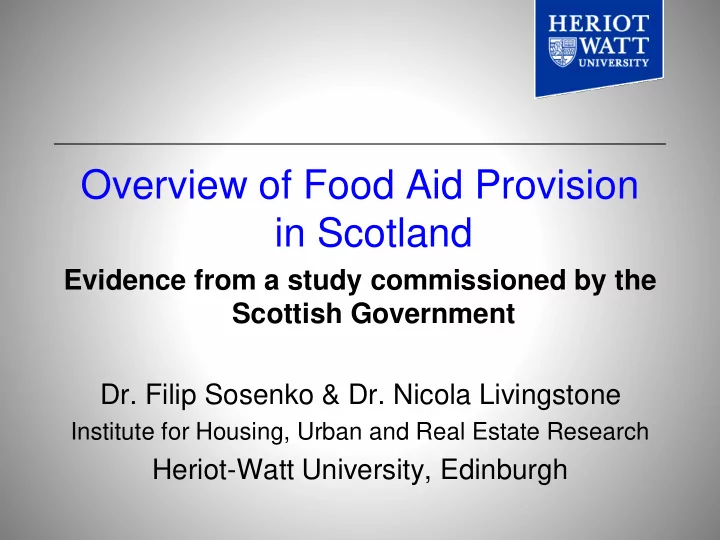

Overview of Food Aid Provision in Scotland Evidence from a study commissioned by the Scottish Government Dr. Filip Sosenko & Dr. Nicola Livingstone Institute for Housing, Urban and Real Estate Research Heriot-Watt University, Edinburgh
Introducing the Project Mapping and studying foodbanks and 'soup kitchens‘ in Scotland. Context : lack of data about the scale of food aid (beyond TT data) and about the role played by welfare reform. Objectives (1): Identify providers; scale of provision; methods of operation; client base; monitoring systems. Objectives (2): How dominant is TT? Is TT client base typical? Can the Scottish Government use Trussell Trust monitoring data as a guide to what non-TT providers are experiencing? If not, what additional research could be undertaken? Objectives (3): Can food aid supply and demand be monitored? Can the impact of welfare reform be monitored? How?
Introducing the Project (2) 8 ‘case study’ locations: Glasgow City, Dundee, Inverness, Fort William, Stirling, Falkirk, Kirriemuir & Forfar (Angus). From large urban to remote/rural. High on the Scottish Index of Multiple Deprivation. Semi-structured telephone interviews with managers of foodbanks and ‘soup kitchens.’
Key Findings Number of food aid providers Providing Location Total Providing meals food parcels Glasgow City 35 26 27 Dundee City 12 3 9 Stirling 2 2 1 Falkirk 2 2 1 Inverness 1 1 0 Fort William 1 1 0 Kirriemuir 1 1 0 Forfar 1 1 0 Total 55 37 38
Key Findings (contd.) TT represents around 20% of food parcel provision in Glasgow but is dominant in Dundee, Inverness, Falkirk, Angus and Fort William. Foodbanks mainly used by people who are housed but have no/small income. ‘Soup kitchens’ mainly used by homeless people who also tend to have long-standing issues (substance misuse, mental health, etc.) Glasgow also has destitute migrants/asylum seekers. TT clientele to an extent different from clients of other foodbanks: more clients experiencing a ‘one - off’ crisis, fewer with long-standing issues.
Key Findings (contd.) All providers have experienced increase in demand (broadly in line with the rate of increase observed by TT) Perceived factors behind rising demand: welfare reform, benefit delays, benefit sanctions, falling incomes Monitoring systems: robust for TT, patchy for others. Possible to monitor the number of food parcels and meals given out across Scotland Challenges: how many individual beneficiaries? How many of them are ‘repeat users’? But not possible to monitor the profile of food aid beneficiaries. Monitoring the impact of welfare reform (beyond TT data): difficult
Semi-urban & rural Scotland Visibly more foodbanks than ‘soup kitchens’. Logistically more challenging – demand met, but distribution can be necessary (adds additional cost). Considering population size rural areas have a high volume of food aid distribution. Difficult to assess how successful these food banks are in addressing vulnerability in more rural/remote areas. Potential for ‘lost’ beneficiaries (such as the elderly) greater in rural areas, due to lack of awareness and information. Further expansion anticipated.
Recommendations for SG TT data can be used as an indicator of wider trends in demand for food parcels across Scotland. Changes to the welfare system, including the role of welfare reform, delays and sanctions were dominant reasons for using foodbanks. Do not extrapolate TT data onto ‘soup kitchens’ (different client base). Not possible to produce Scotland-wide demographic profile of food aid recipients, due to the complex dynamics of food aid.
Recommend
More recommend